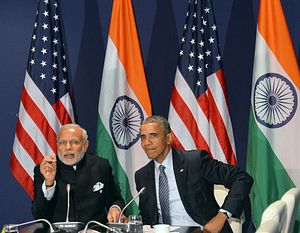Jeffrey Goldberg, writing in the April 2016 issue of The Atlantic, teases out the Obama Doctrine through a series of conversations and interviews with U.S. President Barack Obama spanning several years.
The article is extremely interesting and worth a read because it articulates, for the first time ever, a complete and clear picture of the American president’s intellectual premises on foreign policy and the United States’ role in the world. There are now many follow-up articles that highlight, discuss, or critique Obama’s views or policies in relations to many parts of the world such as Russia, the Middle East, and East Asia, but the careful reader may note one glaring omission: India hardly seems to figure in the Obama Doctrine. The Atlantic article itself has no direct mentions of the Indian state or relations with India, except for a vague concern of Obama’s that climate change could lead to famine and displacement in the Indian subcontinent.
For a president as aware as Obama of the geopolitical calculus in Afghanistan and Pakistan and the strategic consequences of the rise of China in Asia, it is unlikely that he simply neglected to think about the role of a country as large and powerful as India. In short, Obama has neither forgotten nor found the time for India: his relative disinterest in it stems from just that–general indifference. India is simply not important enough in the Obama view of America’s national interests: both its long-term ones in the Asia-Pacific, and the quagmires it constantly gets bogged down in in the Middle East and North Africa.
But this should be no surprise when considering Obama’s overall views as well as the trajectory of Indo-American relations, both of which determine that India will always be a secondary American interest. This is not due to any personal antipathy from either end, but a function of the fact that both countries have drastically different interests and priorities. At the core of the Obama Doctrine is the assertion that due to the nature of the world, the United States has to be selective in choosing where to engage: “And in order to advance both our security interests and those ideals and values that we care about, we’ve got to be hardheaded at the same time as we’re bighearted, and pick and choose our spots….” And India is not a spot that has been chosen, in particular, for engagement.
While it is evident that Obama recognizes Russia and China as poles that could potentially play roles in world affairs similar to that of the United States, this consideration does not extend to India. Partially this is because India itself has refused to be drawn into the complex politics of the greater Middle East or the balancing schemes of the Asia-Pacific; for example, India turned down an offer to jointly patrol the South China Sea with the United States. India’s diplomatic contributions to important world issues, such as Iran’s nuclear program or the Syrian crisis, have been paltry and minimal, even under the more active premiership of Narendra Modi. Of course, the Indian government cannot be entirely blamed for this, since India’s political structure incentivizes focusing on domestic politics.
Seen in this light, the policies of the George W. Bush administration, such as the civil nuclear deal, that sought to build up India as a counterbalance to China were an aberration rather than the rule. The Bush administration failed to appreciate India’s commitment to avoiding alliances or seeming as though it was allying with any of the other great powers. It can even be argued that the Indian government milked the Bush administration for the nuclear deal without really giving much back strategically.
Of course, the Obama administration has not completely neglected India. It recognizes that India, with its population and economy, could soon potentially be a major player and that India in particular likes to be treated as a global power and fêted on the world stage. Obama was the special guest for India’s 2015 Republic Day Parade, a first for a sitting American president, and Modi paid a visit to the United States in 2014 where he reportedly “bonded” with Obama.
There are many advocates of stronger Indo-American ties from all major American and Indian political parties, but ultimately the most they are likely to achieve are better trade deals or increased people-to-people and cultural ties.
The limits of the United States really caring about India and its interests are evidenced by the actions of the Obama administration. For example, Obama cut short his Republic Day visit to India to attend the funeral of Saudi King Abdullah in 2015. It is impossible to not draw the message that Saudi Arabia, a country with less than 5 percent of the population of India, is more important to American interests that India. And sadly for Indian policymakers, there may well be a legitimate basis for this to be the case, because Saudi Arabia, despite its low population and lack of non-petroleum resources, is somehow more intensely involved in global and regional geopolitics than India is.
Ultimately, it is clear that in practice, the Obama Doctrine has a limited place for India, since there is not much the United States can achieve in its relations with India and because there are no pressing security issues that involve India. This is true even with regard to Afghanistan’s stability, where the roles of Pakistan, China, and Iran are more vital. Indian policy-makers should take note of all this, accept it as a fact without feeling hurt or insulted, and conduct policy accordingly.

































